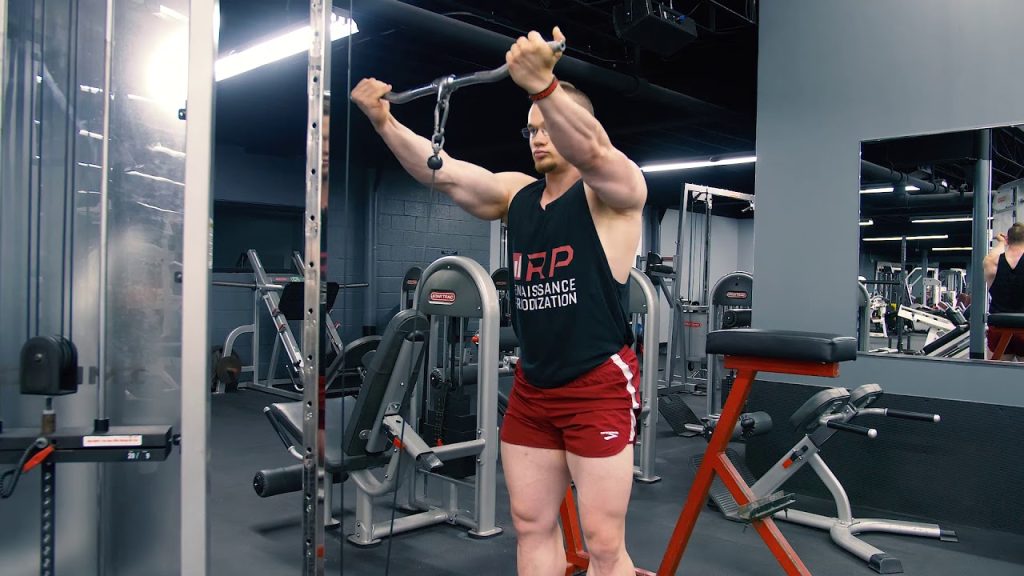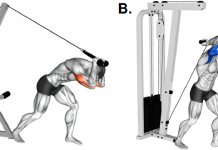Comprehensive Guide to Cable Front Raises
When it comes to achieving a well-rounded and sculpted physique, strong and defined shoulders are a must. Not only do they enhance your overall appearance, but they also play a crucial role in daily activities, from lifting groceries to reaching high shelves. Among the many exercises designed to target your shoulder muscles, the cable front raise stands out as a highly effective choice.
In this comprehensive guide, we’ll dive deep into the world of cable front raises, uncovering the nuances of this exercise, its benefits, proper execution, and much more. Whether you’re a seasoned gym-goer or a beginner looking to enhance your fitness routine, this article is your key to mastering the cable front raise.
Understanding the Cable Front Raise
Before you start incorporating cable front raises into your workout routine, it’s essential to understand the exercise itself. This understanding will not only help you perform it correctly but also maximize its benefits.
Cable Front Raise: What is it? The cable front raise is a resistance training exercise primarily designed to target the anterior deltoids—the front muscles of your shoulders. By using a cable machine, you create constant tension on your shoulder muscles throughout the entire range of motion, making it a potent tool for muscle growth and strength development.

Proper Form and Technique To perform cable front raises effectively, you’ll need to pay close attention to your form and technique. Here’s a step-by-step breakdown:
- Setup: Stand facing the cable machine with the pulley set to the lowest position. Attach a straight bar or rope handle.
- Body Position: Maintain a straight posture with a slight bend in your knees. Engage your core for stability.
- Grip: Grab the handle with an overhand grip, hands shoulder-width apart.
- Execution: Slowly lift the handle before you while keeping your arms straight but not locked. Lift to shoulder height or slightly above.
- Lower: Control the handle back down to the starting position. This completes one repetition.
Remember to breathe steadily and maintain control throughout the movement. Avoid using momentum or swinging your body to lift the weight.
Equipment and Setup
To get started with cable front raises, you’ll need access to a cable machine. These machines can be found in most gyms and offer various attachments like straight bars, rope handles, or single handles. Here’s how to set up for this exercise:
- Adjust the Weight: Begin by selecting an appropriate weight on the cable machine’s weight stack. If you’re new to this exercise, start with a lighter weight to practice proper form.
- Pulley Height: Ensure the pulley is set to the lowest position to perform front raises effectively.
- Handle Attachment: Choose your preferred attachment, such as a straight bar or rope handle, and connect it to the cable.
Step-by-Step Execution
Now that you’re familiar with the setup, it’s time to master the execution of cable front raises. Proper form is essential to target the right muscles and avoid injury.
Step 1: Starting Position
- Stand upright, facing the cable machine with your feet shoulder-width apart.
- Attach the handle to the low pulley and hold it with an overhand grip, hands slightly wider than shoulder-width apart.
- Keep a slight bend in your knees, engage your core for stability, and maintain a neutral spine.
Step 2: The Raise
- Begin the movement by slowly lifting the handle in front of you.
- Maintain a slight bend in your elbows but keep your arms straight (but not locked).
- Lift the handle to shoulder level or slightly above, focusing on using your shoulder muscles to lift the weight.
- Ensure a controlled and deliberate movement, avoiding any swinging or jerking motions.
Step 3: Lowering
- Slowly lower the handle back to the starting position under control.
- This completes one repetition.
Perform the desired number of repetitions and sets, typically ranging from 3 to 4 sets of 8 to 12 repetitions. Remember to maintain steady and controlled breathing throughout the exercise.
Variations and Modifications
Variety is key to continuous progress in your fitness journey. Cable front raises offer several variations and modifications to keep your workouts interesting and target different aspects of your shoulder muscles.
1. Single-Arm Cable Front Raise
- Perform cable front raises one arm at a time for improved focus and isolation.
- This variation can help identify and correct muscle imbalances.
2. Rope Attachment
- Swap the straight bar for a rope handle to engage your grip and forearm muscles during the exercise.
- It also allows for a different range of motion.
3. Reverse Grip Front Raise
- Hold the handle with an underhand grip (palms facing up) to shift the emphasis to the lower part of the anterior deltoids.
Incorporate these variations into your routine strategically, focusing on your specific fitness goals and addressing any weaknesses or imbalances.
Benefits of Cable Front Raises
Understanding the advantages of cable front raises can further motivate you to include this exercise in your workouts:
1. Targeted Muscle Growth
- The cable front raises specifically to engage the anterior deltoids, promoting muscle growth and a defined shoulder line.
2. Constant Tension
- The cable machine provides continuous tension on your muscles throughout the exercise, maximizing muscle activation.
3. Injury Prevention and Rehabilitation
- Strengthening the shoulder muscles can help prevent injuries and aid in rehabilitation if you have shoulder issues.
4. Versatility
- Cable front raises can be easily adjusted to suit your fitness level, making them suitable for both beginners and advanced lifters.
Common Mistakes to Avoid
While cable front raises are an effective shoulder exercise, it’s crucial to be aware of common mistakes to ensure you get the most out of your workout while minimizing the risk of injury.
1. Using Excessive Weight
- One of the most common errors is selecting a weight that’s too heavy. This can lead to improper form and strain on your shoulder joints. Start with a manageable weight and gradually increase it as you build strength.
2. Swinging the Body
- Jerking or swinging your body to lift the weight not only reduces the effectiveness of the exercise but also puts undue stress on your lower back. Maintain a stable, upright posture throughout the movement.
3. Overarching the Back
- Arching your back excessively while lifting the weight can lead to back strain. Keep your core engaged and maintain a neutral spine to protect your lower back.
4. Neglecting the Full Range of Motion
- Some individuals may only perform partial front raises. To maximize muscle engagement, aim to lift the weight to at least shoulder height or slightly higher, ensuring a complete range of motion.
5. Ignoring Breathing
- Improper breathing can disrupt your rhythm and form. Inhale as you lower the weight and exhale as you raise it, maintaining a controlled and steady pace.
By being mindful of these common mistakes and focusing on proper form, you’ll make the most of your cable front raise workouts.
Sample Workout Routine
To help you integrate cable front raises into your fitness routine effectively, here’s a sample workout plan:
Exercise: Cable Front Raises
Sets: 3
Repetitions: 10-12
Rest Between Sets: 60-90 seconds
- Warm-up: Start with a five-minute light cardio warm-up to increase blood flow to your muscles.
- Cable Front Raises: Perform three sets of 10-12 repetitions, following proper form and technique as described earlier.
- Superset: Pair cable front raises with a complementary exercise, such as lateral raises, to target different areas of your shoulder muscles.
- Cool Down: Finish with a gentle stretching routine for your shoulder muscles to improve flexibility and reduce post-workout soreness.
FAQs
Q1: What is the difference between cable front raises and dumbbell front raises?
- A: Cable front raises use a cable machine, providing constant tension throughout the movement. Dumbbell front raises, on the other hand, use free weights and may not offer the same level of tension control.
Q2: Can cable front raises help with shoulder pain?
- A: When performed with proper form and appropriate weight, cable front raises can help strengthen the shoulder muscles, potentially reducing the risk of shoulder pain. However, consult a healthcare professional if you have existing shoulder issues.
Q3: Is it necessary to use a cable machine, or are there alternatives?
- A: While cable machines are ideal for cable front raises, you can mimic the exercise with resistance bands or dumbbells. However, the constant tension provided by a cable machine is unique.
Q4: How often should I include cable front raises in my workout routine?
- A: Including cable front raises 1-2 times per week in your shoulder workout routine is generally sufficient. Ensure proper recovery time between sessions.
Q5: Are there any precautions for individuals with shoulder injuries?
- A: If you have a history of shoulder injuries or pain, consult a physical therapist or healthcare professional before incorporating cable front raises. They can guide whether this exercise is suitable for you.
Conclusion
Mastering the cable front raise can be a game-changer for your shoulder development and overall upper-body strength. By consistently incorporating this exercise into your fitness routine and adhering to proper form and technique, you’ll reap a multitude of benefits, from sculpted shoulders to improved functional strength.
Remember that consistency is key in achieving your fitness goals. Whether you’re aiming for a more aesthetic physique or seeking to enhance your shoulder strength for practical reasons, cable front raises can play a vital role in your journey.
To summarize:
- Cable front raises target the anterior deltoids and provide constant muscle tension.
- Proper form and technique are essential for safety and effectiveness.
- Variations and modifications add versatility to your workouts.
- Avoid common mistakes to maximize results and prevent injury.
- A structured workout routine can help you progress steadily.
- Consult with a healthcare professional if you have any existing shoulder issues.
Incorporate cable front raises intelligently into your workout regimen, pair them with other shoulder exercises, and track your progress. With dedication and consistency, you’ll witness the transformation of your shoulder muscles and overall upper body strength.
Now, it’s time to hit the gym and put your newfound knowledge of cable front raises to the test. Get ready to sculpt those shoulders and embark on a journey to a stronger, more confident you.
Stay motivated, stay focused, and let your dedication be the driving force behind your fitness success.




